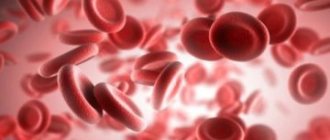Genetic factors
Thrombophilia, which is inherited, is a genetically determined tendency to form blood clots. When two or more disorders in the coagulation system are combined, severe thrombotic disorders can develop in early childhood. However, more often a hereditary increase in blood clotting is caused by one disorder, which is detected by chance during a laboratory blood test 2.
There are two main types of thrombophilias: hematogenous, associated with changes in the blood coagulation system, and non-hematogenous. Today, at least 20 genetic factors associated with the development of the disease are known. They are divided into three groups2:
- Installed:
- factor V Leiden is a mutation in which, due to amino acid substitutions in the protein chain of coagulation factor V, it becomes resistant to the action of one of the main anticoagulant agents, activated protein C.
Mutation G20210A prothrombin II, which changes the level of blood coagulation factor II prothrombin.
- Deficiency of protein C, which inactivates blood coagulation factors Va and VIIIa. Less common than the previous two mutations, it usually leads to the development of familial venous thrombosis.
- Deficiency of protein S - a cofactor of protein C, which enhances its anticoagulant and fibrinolytic activity.
- • Deficiency of antithrombin, the main protein factor that inhibits blood clotting. It is transmitted in an autosomal dominant manner, that is, it manifests itself only in the presence of at least one defective gene.
- Undefined:
- Dysfibrinogenemia is a condition in which the fibrinogen content is normal, but the fibrinogen molecule itself is altered. It is most often transmitted by autosomal inheritance, that is, for the disease to manifest, the defective gene must be passed on from both parents. Usually manifests itself as moderate bleeding due to injury or surgery.
Hyperhomocysteinemia. It can be both a hereditary and acquired disorder 2. Associated with rare genetic defects that lead to an increase in the concentration of homocysteine in the urine and blood plasma. Homocysteine exhibits a pronounced toxic effect, damaging the inner surface of blood vessels, significantly increasing the risk of thrombosis.
- Rare.
Rare factors of thrombophilia include increased concentrations of blood coagulation factors VIII, IX, XI, VII, XII, plasminogen deficiency, tissue plasminogen activation, increased lipoprotein A, platelet glycoprotein polymorphism, thrombomodulin gene defect, and other factors.
How does thrombophilia manifest?
The presence of thrombophilia can be suspected in the following conditions 2:
- Repeated venous thromboembolism
- Venous thrombosis under the age of 40 years
- Venous thromboembolism in relatives
- Thrombosis of unusual localization, for example, mesenteric vein, renal vein, liver, cerebral thrombosis.
It should be noted that most often thrombophilia leads to venous thrombosis, however, deficiency of proteins C, S and antithrombin can also manifest as thrombosis in the arteries. The latter cause myocardial infarction and acute cerebrovascular accident - stroke.
Diagnosis of thrombophilia
Timely diagnosis of genetic (hereditary) thrombophilia plays an important role in the prognosis of the disease. Early detection of the disease allows you to make the necessary adjustments to your lifestyle and thus prevent pathological thrombus formation.
Since inherited thrombophilia can be associated with various genetic factors, its diagnosis is complex. The doctor’s task is to confirm or refute the presence of mutations associated with impaired blood clotting activity.
The tests that will have to be taken if you suspect hereditary thrombophilia include3:
Detailed coagulogram with determination of the level of blood coagulation factors and physiological anticoagulants.
A coagulogram allows you to identify deviations in the hemostatic system and determine the type of thrombophilia and the deficiency of which coagulation factors is observed.
- Determination of homocysteine levels to help diagnose hyperhomocysteinemia.
- Determination of thrombomodulin content, von Willebrand factor activity, as well as the concentration of endothelin-1, necessary to obtain information about possible vascular damage due to thrombophilia.
- Genetic study of polymorphism of genes of those factors that are involved in hemostasis.
Hereditary thrombophilia and pregnancy
The relationship between inherited thrombophilias and pregnancy complications, for example, preeclampsia, eclampsia, spontaneous abortion, fetal growth restriction, and placental abruption still remains controversial4. Nevertheless, some obstetric complications are still caused by thrombophilias.
Thus, a number of studies indicate a possible connection between fetal loss in the second and third trimesters of pregnancy with the presence of hereditary thrombophilia6. This is explained by impaired blood circulation in the vessels of the placenta due to the formation of blood clots in it. However, it is important to emphasize that spontaneous fetal losses in the early stages of pregnancy (in the first trimester) are often not related to thrombophilia.
However, the presence of genetic thrombophilia in pregnant women may increase the risk of venous thromboembolic complications5. Even normally, in healthy women during pregnancy, the blood coagulation system is activated: physiological hypercoagulation is observed (increased blood clotting), and there is also venous stagnation. However, in pregnant women suffering from thrombophilia, coagulation increases even more, which can lead to an increased risk of thrombosis, primarily in venous vessels7.
The formation of venous stagnation in expectant mothers can also be facilitated by a decrease in physical activity, for example, with some complications of pregnancy, as well as after a cesarean section 7.
Diagnosis of thrombophilia during pregnancy is difficult, since a number of indicators increase both in pathology and in healthy women, and the longer the pregnancy, the higher the risk of thrombosis. To make a diagnosis, they resort to genetic research, which is usually carried out on the recommendation of the attending physician if there are certain indications, for example, in the presence of a history of venous thrombosis of the lower extremities or the presence of venous thrombosis in close relatives.
When do you need to take the THROMBOPHILIA extended test?
- Cases of hereditary thromboembolism in the family.
- History of thrombosis:
- single thrombosis before 50 years of age;
- repeated thromboses;
- a case of thrombosis at any age with a family history;
- thrombosis of unusual localization (portal, mesenteric, cerebral veins);
- thrombosis of unknown etiology after 50 years.
- High risk situations:
- massive surgical interventions;
- long-term immobilization;
- oncological diseases;
- chemotherapy.
- Ischemic stroke.
- Cardiovascular diseases.
- Prescription of standard antiplatelet therapy.
- Use of hormonal contraception or hormone replacement therapy.
- Planning pregnancy in women with a history of thrombosis, 1st degree relatives with diagnosed hereditary thrombophilia, or a family history of thromboembolic complications.
- Complicated obstetric history.
Prevention of thrombosis
Prevention of thrombosis in thrombophilia in most cases is based on lifestyle changes. Patients are advised to avoid strenuous exercise and injury while maintaining the same amount of physical activity. An important preventive measure is wearing compression stockings. Doctors always decide on preventive measures strictly individually after assessing the thrombotic risk.
Bibliography
- Kyrle PA, Rosendaal FR, Eichinger S. Risk assessment for recurrent venous thrombosis //Elsevier.2010;376(9757):2032–2039.
- Khan S., Dickerman JD Hereditary thrombophilia. // Thromb. J. BioMed Central. 2006;4:15.
- Vasiliev S.A., Vinogradov V.L., et al. Thrombosis and thrombophilia: classification, diagnosis, treatment, prevention // RMZH - 2013.- No. 17. - P.896.
- Robertson L. et al. Thrombophilia in pregnancy: a systematic review // Br. J. Haematol. Blackwell Science Ltd.2006;132(2):171–196.
- Sibai BM, How HY, Stella CL Thrombophilia in pregnancy: Whom to screen, when to treat. 2007;19(1):50–64.
- Battinelli EM, Marshall A., Connors JM The role of thrombophilia in pregnancy. // Thrombosis. Hindawi.2013; 2013:516420.
- Andriyashkin A.V. Russian clinical recommendations for the diagnosis, treatment and prevention of venous thromboembolic complications // Phlebology - 2015. -T. 9. – No. 2. – P.1–52.
SARU.ENO.19.03.0436
Test for thrombophilia. Genetic (hereditary) thrombophilia: which genes are responsible for it?
Thrombophilia testing most often involves the study of thrombophilia genes or so-called “hemostasis mutations”
.
Thrombophilia
– predisposition to the development of thrombosis. It can be hereditary (genetic) and acquired. Acquired thrombophilia develops as a result of exposure to external or internal factors affecting the body (for example, medications, certain diseases). Genetic thrombophilia is a predisposition to thrombosis due to genetic defects in the hemostatic system. Thrombophilia during pregnancy is associated with various obstetric complications - miscarriage, impaired placental function, preeclampsia.
“Mutations” of hemostasis in the diagnosis of genetic thrombophilia
In our laboratory, testing for mutations in hemostasis genes has two options:
- Polymorisms of hemostasis genes, 4 factors
— the basic block consists of 4 indicators:
| prothrombin gene (factor II, G20210A) | Leiden mutation (factor V gene, G1691A) |
| MTHFR gene (MTHFR, C677T) | plasminogen activator gene (PAI-I, 675 5G/4G) |
- Polymorphism of genes of the hemostatic system, fibrinolysis system and folate metabolism, 16 factors (associated with miscarriage, placental function disorders, unsuccessful IVF attempts and infertility of unknown origin).
Thrombophilia gene variants are divided into more “dangerous” and less dangerous. Some of them are more common than others.
It is traditionally believed that mutations in hemostasis genes that predispose to the development of thrombosis have a greater impact - these are the corresponding polymorphisms of the genes MTHFR (methylenetetrahydrofolate reductase), prothrombin (factor II), PAI-I, factor V (Leiden mutation), included in the block “Gene polymorphisms” hemostasis system, 4 factors.” This examination reveals a fairly large percentage of problems. But sometimes, beyond the scope of this standard examination, hidden factors remain that can complicate the course of pregnancy, the use of contraceptives, and surgical interventions, therefore, to obtain more information about potential risks, it is advisable to take an extended analysis of 16 factors.
If you have never taken the “Polymorphisms of genes of the hemostasis system” test, take the full block of 16 indicators!
Indications for testing:
- In the past there were pregnancy complications, miscarriage, fetal development arrest, gestosis, unsuccessful IVF attempts.
- Your relatives had diseases of the cardiovascular system.
- You are planning contraception (it is important to conduct a comprehensive examination - hormones, hemostasis, biochemical parameters).
- Your lifestyle is associated with a risk of injury or, on the contrary, you lead a sedentary lifestyle
- You are preparing for planned surgical treatment (especially “major” operations).
- You want to know about the risks of developing a particular pathology. This knowledge will really help you plan your life in such a way as to prevent diseases that reduce your quality of life.








